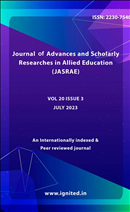4-((E)-3-(4- (octyloxy)phenyl)acryloyl)phenylboronic Acid: Synthesis and Health Benefits
Keywords:
immune system, lymph nodes, tonsils, adenoids, thymus, germs, defences, pathogen, innate immune system, adaptive immune system, macrophages, dendritic cells, specific immunity, antibodies, chalcones, anticancer, anti-inflammatory effects, clinical trials, boronic Chalcone derivative, immunomodulatory effectsAbstract
When it comes to protecting the body from harmful substances, the immune system is firstline of defence. Lymph nodes, tonsils, adenoids, and the thymus are only few of the organs and tissuesthat make up the human immune system. Germs need to get past the body's natural defences, suchmucus and enzymes, before they can infect a host. In order to begin destroying healthy cells, they mustfirst overcome these barriers. If a pathogen is able to get past the first layer of defence, it will be sent tothe next level of protection. There are two main types of immune system responses to infections innateand adaptive. Host innate or nonspecific immune cells like macrophages and dendritic cells areresponsible for the early response to infections. Specific immunity, or acquired immunity, is establishedby the body's manufacture of antibodies that are highly specific to the antigens that caused an infection.Both naturally occurring chalcones and synthetically synthesised chalcones, together with theirrespective derivatives, have been shown to possess intrinsic anticancer and anti-inflammatory effects.Clinical trials are currently the only reliable means of gauging a treatment's potential therapeutic benefit.In order to create more effective molecules, it would be helpful to have access to compounds with welldefinedmechanisms of action. In this research, we synthesised a boronic Chalcone derivative andanalysed its immunomodulatory effects.Downloads
References
Akira S, Uematsu S, Takeuchi O. Pathogen recognition and innate immunity. Cell. 2006;124(4):783–801.
Shalhoub J, Falck-Hansen MA, Davies AH, Monaco C. Innate immunity and monocyte-macrophage activation in atherosclerosis. J Inflamm (Lond). 2011;8:9.
Davoudi S, Rasoolinegad M, Younesian M, et al. CD4+ cell counts in patients with different clinical manifestations of tuberculosis. BrazJ Infect Dis. 2008;12(6):483–486.
Macdonald SH, Woodward E, Coleman MM, et al. Networked T cell death following macrophage infection by Mycobacterium tuberculosis. PLoS One. 2012;7(6):e38488.
Wilson HM. Macrophages heterogeneity in atherosclerosis – implications for therapy. J Cell Mol Med. 2010;14(8):2055–2065.
Kantarci OH, Pirko I, Rodriguez M. Novel immunomodulatory approaches for the management of multiple sclerosis. ClinPharmacolTher. 2014;95(1):32–44.
Arnson Y, Shoenfeld Y, Amital H. Intravenous immunoglobulin therapy for autoimmune diseases. Autoimmunity. 2009;42(6):553–560.
Frölich S, Schubert C, Bienzle U, Jenett-Siems K. In vitro antiplasmodial activity of prenylatedchalcone derivatives of hops (Humuluslupulus) and their interaction with haemin. J AntimicrobChemother. 2005;55(6):883–887.
Abdula AM. Synthesis, characterization and antibacterial activity of (E)-chalcone derivatives. Eur J Chem. 2013;4(3):207–210.
Kim KN, Ko YJ, Kang MC, et al. Anti-inflammatory effects of trans-1,3-diphenyl-2,3-epoxypropane-1-one mediated by suppression of inflammatory mediators in LPS-stimulated RAW 264.7 macrophages. Food ChemToxicol. 2013;53:371–375.
Ku BM, Ryu HW, Lee YK, et al. 4′-Acetoamido-4-hydroxychalcone, a chalcone derivative, inhibits glioma growth and invasion through regulation of the tropomyosin 1 gene. BiochemBiophys Res Commun. 2010;402(3):525–530.
Rizvi SUF, Ahmad M, Bukhari MH, et al. Anti-HIV-1 screening of (2E)-3-(2-chloro-6-methyl/methoxyquinolin-3-yl)-1-(aryl)prop-2-en-1-ones. Med Chem Res. 2014;23(1):402–407.
Mohamad AS, Akhtar MN, Zakaria ZA, et al. Antinociceptive activity of a synthetic chalcone, flavokawin B on chemical and thermal models of nociception in mice. Eur J Pharmacol. 2010;647(1–3):103–109.
Bukhari SN, Lauro G, Jantan I, Bifulco G, Amjad MW. Pharmacological evaluation and docking studies of α,β-unsaturated carbonyl based synthetic compounds as inhibitors of secretory phospholipase A2, cyclooxygenases, lipoxygenase and proinflammatory cytokines. Bioorg Med Chem. 2014;22(15):4151–4161.
Bukhari SN, Tajuddin Y, Benedict VJ, et al. Synthesis and evaluation of chalcone derivatives as inhibitors of neutrophils’ chemotaxis, phagocytosis and production of reactive oxygen species. ChemBiol Drug Des. 2014;83(2):198–206.
Alam MS. Biological potentials of chalcones: a review. Int J Pharm BiolSci Arch. 2012;3(6):1298–1303.
Rahman MA. Chalcone: a valuable insight into the recent advances and potential pharmacological activities. ChemSci J. 2011;2011(2):CSJ-29.
Yadav VR, Prasad S, Sung B, Aggarwal BB. The role of chalcones in suppression of NF-κB-mediated inflammation and cancer. IntImmunopharmacol. 2011;11(3):295–309.
McKoy DL. Synthesis And Characterization Of Boronic Acid Chalcones As Potential Cancer Chemoprevention Drug Candidates. 2013.
Warrington R, Watson W, Kim HL, Antonetti FR. An introduction to immunology and immunopathology. Allergy Asthma ClinImmunol. 2011;7Suppl 1:S1–S8.
Delves PJ, Roitt IM. The immune system. New Engl J Med. 2000;343(1):37–49.
Bonilla FA, Oettgen HC. Adaptive immunity. J Allergy ClinImmunol. 2010;125(2 Suppl 2):S33–S40.
Krampera M, Cosmi L, Angeli R, et al. Role for interferon-gamma in the immunomodulatory activity of human bone marrow mesenchymal stem cells. Stem Cells. 2006;24(2):386–398.
English K, Barry FP, Field-Corbett CP, Mahon BP. IFN-gamma and TNF-alpha differentially regulate immunomodulation by murine mesenchymal stem cells. Immunol Lett. 2007;110(2):91–100.
Liu X, Zhao M, Wu K, et al. Immunomodulatory and anticancer activities of phenolics from emblica fruit (Phyllanthusemblica L.). Food Chem. 2012;131(2):685–690.
Ogechukwu OE, Ogoamaka OP, Sylvester NC, et al. Steroids and triterpenoids from Eastern Nigeria mistletoe, Loranthusmicranthus Linn. (Loranthaceae) parasitic on Kola acuminata with immunomodulatory potentials. Phytochem Lett. 2011;4(3):357–362.
Arya V, Gupta VK. A review on marine immunomodulators. IntJ Pharm Life Sci. 2011;2(5):751–758.











